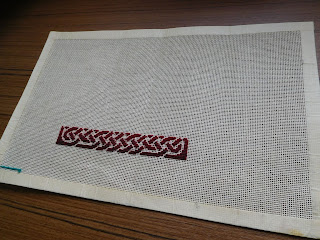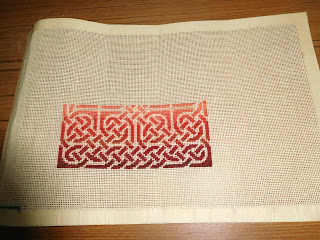Remember this?
Late last year I began making a little tapestry panel, with a view to replacing my everyday bag.
Some years ago, I paid about seven pounds for this little bag at a craft centre in Maldon. It had no label but was almost certainly put together in the Far East, perhaps repurposing a piece of existing embroidery. I remember thinking that it was a lot to pay for an impulse buy, and that I might never actually use it. In fact, it has been a constant companion, not least because it is made of fabric and tucks very comfortably under my arm, which many small bags won't do.
For the panel, I used a chart from Co Spinhoven's "Charted Celtic Designs", a wonderful resource. I had the canvas and the crewel yarn from previous charity shop purchases, although I had to top up the threads when I ran out of some crucial colours.
But then the panel was complete, so assembly of the finished item could begin. So, two six-inch zips were needed. I just happened to have some brown poplin fabric and some calico for the lining, but I needed dark brown cord. By now I have spent way beyond the seven pounds of the original, even though I have many of the items in store already.
I imagine the original was part of a batch for export, and speed would have been of the essence. Perhaps the maker sat at a sewing machine all day knocking out bag after bag. Even so I take my hat off to her. The accuracy of the stitching is admirable. I examined my bag very carefully to reverse engineer the construction - it has a separate, lined section for credit cards. Slowly I worked out the sequence needed.
With Storm Doris blowing over, I could put off the construction no longer. Several hours of pinning, tacking and trimming later, I end up with this finished item.
I'm very happy with it. The dark brown poplin may seem like an odd choice, but it is lined throughout so it should be quite hard-wearing. And it is almost up to the standard of the original.
Late last year I began making a little tapestry panel, with a view to replacing my everyday bag.
Some years ago, I paid about seven pounds for this little bag at a craft centre in Maldon. It had no label but was almost certainly put together in the Far East, perhaps repurposing a piece of existing embroidery. I remember thinking that it was a lot to pay for an impulse buy, and that I might never actually use it. In fact, it has been a constant companion, not least because it is made of fabric and tucks very comfortably under my arm, which many small bags won't do.
For the panel, I used a chart from Co Spinhoven's "Charted Celtic Designs", a wonderful resource. I had the canvas and the crewel yarn from previous charity shop purchases, although I had to top up the threads when I ran out of some crucial colours.
But then the panel was complete, so assembly of the finished item could begin. So, two six-inch zips were needed. I just happened to have some brown poplin fabric and some calico for the lining, but I needed dark brown cord. By now I have spent way beyond the seven pounds of the original, even though I have many of the items in store already.
I imagine the original was part of a batch for export, and speed would have been of the essence. Perhaps the maker sat at a sewing machine all day knocking out bag after bag. Even so I take my hat off to her. The accuracy of the stitching is admirable. I examined my bag very carefully to reverse engineer the construction - it has a separate, lined section for credit cards. Slowly I worked out the sequence needed.
With Storm Doris blowing over, I could put off the construction no longer. Several hours of pinning, tacking and trimming later, I end up with this finished item.
I'm very happy with it. The dark brown poplin may seem like an odd choice, but it is lined throughout so it should be quite hard-wearing. And it is almost up to the standard of the original.


















.JPG)